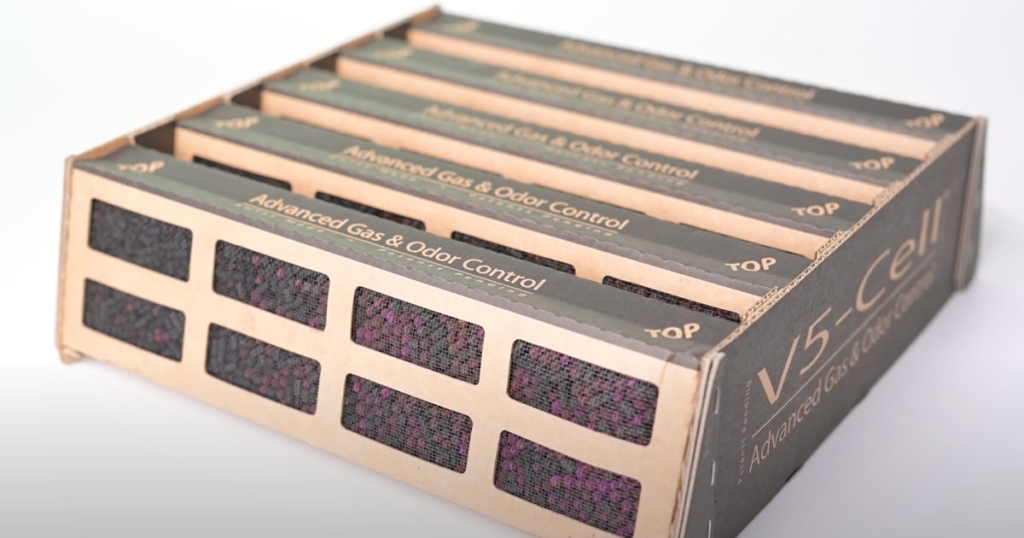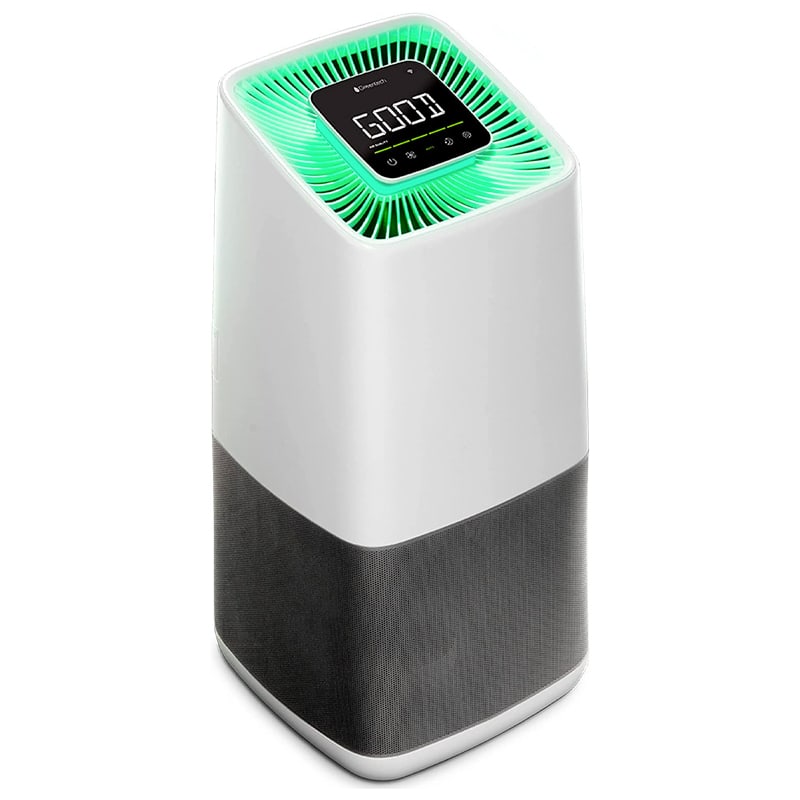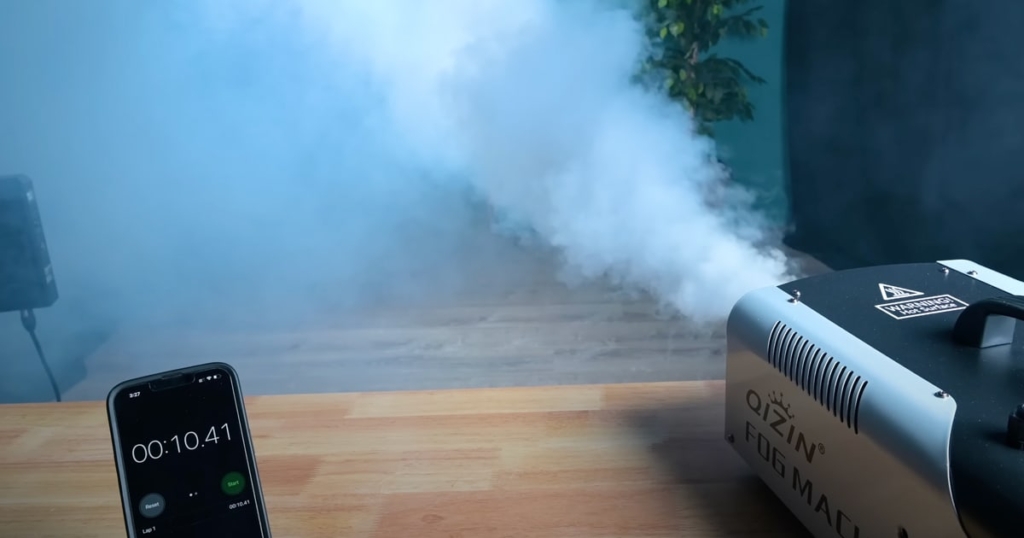This week we’re testing two of the most expensive air purifiers on the market: the IQAir HealthPro Plus and the Greentech Environmental pureAir Active HEPA+ Pro. We were really curious to see how these air purifiers perform as they take different approaches to cleaning indoor air.
Here’s what we found in our first matchup. We’re calling it ‘Air Purifier Wars’ as we set out to find the best air purifier on the market today.
IQAir HealthPro Plus
The Swiss-made IQAir HealthPro Plus shows up as number one on many lists of best air purifiers. This is mostly because of its extremely high-quality filtration process.

Pre-filter
A large pre-filter on the bottom traps coarse particles like pollen, pet dander, and mold spores.
HEPA filter
There is a huge HEPA filter on the top, called hyperHEPA, that IQAir designed themselves. They say it can trap particles down to .003 microns, which is a hundred times smaller than normal HEPA filters are rated for.
RELATED: Sold on an IQAir? See our comparison of the IQAir HealthPro Plus and GC MultiGas air purifiers.
Activated carbon module
The big difference between the IQAir HealthPro Plus and other air purifiers is its massive activated carbon module. This is what absorbs odors, gasses, chemicals, and VOCs, such as formaldehyde. It contains the most activated carbon we’ve ever seen on a consumer air purifier and it really makes IQAir stand apart when it comes to VOC and odor reduction.

On its website, IQAir defines the HealthPro Series as “award-winning, medical-grade air filtration.” In addition to the HealthPro Plus, IQAir sells several indoor air purifiers, air purifiers for use in vehicles, and a whole-house air purifier.
Greentech pureAir Active HEPA+ Pro
Greentech Environmental is a relative newcomer to the market and their pureAir Active HEPA+ Pro is all about new air purifier technology.

HEPA filtration with ODOGard coating
The Greentech pureAir Active HEPA+ Pro uses a traditional HEPA filter that also has a special coating called ODOGard. This coating is designed to break down chemical compounds that cause odors.
See our comparison of Dyson’s Pure Hot+Cool HP04 vs Alen’s BreatheSmart 75i!
Photocatalytic Oxidation
The pureAir Active HEPA+ Pro’s HEPA filter works in combination with bipolar ionization and photocatalytic oxidation, which use UV light to create molecules that actively purify the air.

The Greentech website states that the air purifier is “the only purifier to combine both active and passive air purification technologies with the odor-eliminating power of ODOGard. In addition to reducing volatile organic compounds (VOCs), allergens such as pollen and pet dander, and odors caused by mold, bacteria and other pollutants.”
IQAir HealthPro Plus vs Greentech pureAir Active HEPA+ Pro
Features
The first category we’ll look at is features. These are things that don’t necessarily help with air purification but are nice to have. As you can see, Greentech absolutely dominated this category scoring 88 points to only 19 points for the IQAir.

For example, only the Greentech has a built-in particle sensor that can detect dirty air, indicate it on the screen, and even change color. The particle sensor also allows it to have an auto mode, so it can also automatically increase fan power when it detects dirty air, which is a pretty useful feature.
The Greentech pureAir Active HEPA+ Pro also has an app that allows monitoring of basic air quality, temperature, and humidity. It also has Amazon Alexa compatibility and a sleep mode while the IQAir does not.

The IQAir also lost points here because of its size. We give it a cubic inches score where smaller is always better. Without even seeing the cubic inch scores you can see that the IQAir unit is just a massive product compared to the Greentech.
Why does that matter? It’s like a piece of furniture all on its own, so you will need to consider where it will work in your house.

Airflow Test
Next, we move on to our bench tests. The IQAir has six power levels to the Greentech’s five. In our airflow tests the IQAir was significantly more powerful with its larger fan.
We measured 127 CFM on max power with the IQAir compared to 71 CFM on the Greentech, which is close to double the amount of airflow.

Noise Levels
Noise level is really important with air purifiers. You want an air purifier that provides the most airflow CFM for each decibel. In this test, we took an average of three of their settings and found that the IQAir was about 25 percent more efficient.

On average the IQAir HealthPro Plus put out one CFM per decibel, beating out the Greentech at three-quarters of a CFM per decibel.
Filters
When it comes to air purifiers the more filter media, the better (generally speaking). So during the bench tests, we measure each air purifier’s filter media area in cubic inches.
The IQAir was the clear winner in this regard with its massive 676 cubic inch HEPA filter. It is easily double the size of the Greentech unit’s HEPA filter. And as we mentioned before, the IQAir also has a better rating with its hyperHEPA filter compared to Greentech’s.
Greentech’s pureAir Active HEPA+ Pro does not have a carbon filter. Instead, it uses its photocatalytic and ionization systems for VOC and odor reduction.

But as we said earlier, the IQAir has a large module, especially compared to the control air purifier which had a typical treated carbon filter.
Testing HEPA filtration
Moving on to our new filtration tests. The first new test is the fog test, which is basically a test of an air purifier’s HEPA filter and fan speed. To perform the test we distribute fog into a room with no vents for 12 seconds. We then measure how quickly the particles are reduced per minute from peak to trough.

We opted for this methodology because it doesn’t matter exactly how much fog was distributed, only how fast the air purifier reduces the particles.
Here the IQAir was able to clear 41 particles per minute compared to 34 per minute on the Greentech. Our control unit came in at 22 particles per minute.
We suspect that when we get more air purifiers tested in this way, we’ll find that the IQAir and Greentech scores are way above average, but we will see.

VOC Tests
The next test is a TVOC test, which is total volatile organic compounds and a formaldehyde test. We use incense in a ventless room for this test, so it’s also kind of a smoke and a smell (or odor) test.
With the incense test, we also measure the particle reduction per minute (like with the fog test). Because we can be more sure that the amount of smoke released is more or less the same for each test, we also measure the average number of particles released from baseline to baseline, multiplied by the minutes it took it to go from baseline to baseline.

In this test, a lower score is better, and the results were interesting because not only did the IQAir beat the Greentech in both cases, but the very inexpensive control unit also beat the Greentech.
I did some research and found that someone else had done a similar test with different VOCs and had nearly identical results. In that test, they found that air purifiers with carbon filters like the IQAir and the control unit did much better than those that used other technologies like photocatalytic systems.
We did some more digging and found an article in Nature that says although there are lots of benefits to photocatalytic systems for VOC reduction, one of its limitations is that it’s very slow at reducing VOCs.

So, a test like the one we performed isn’t the best way to showcase the VOC-reducing properties of photocatalytic systems.
If you look on the Greentech Environmental website you’ll see that they have some actual laboratory tests published there. You can see that they have some pretty impressive stats for reducing VOCs and odors.
But looking a bit closer, you can also see that the tests they did are often much longer in duration. A few tests were over the period of five days and there was even a 14-day duration test too.
We did perform a longer-duration VOC test and found that they were both able to reduce VOCs to the same level over a longer period of time. But it should be noted that in a house VOCs often show up all of a sudden and in high amounts.
This is similar to the test we did, and why the Nature article suggests that photocatalytic systems, as revolutionary as they are, should ideally be hybrid systems with carbon filters. This type of hybrid system would add the ability to deal with sudden high amounts of VOCs as well.
So, take our non-professional, non-laboratory tests here with a grain of salt.
Value and Filter Replacements
The final category is value, and while these two units are priced almost exactly the same, we also have to take into account their filter replacement costs. We calculated the IQAir HealthPro Plus’ filter replacement cost at $150 per year compared to the pureAir Active HEPA+ Pro’s $175 per year. /image

Though the Greentech does not have a carbon filter, its photocatalytic unit does need to be replaced every one to two years, so it’s not that much of a cost savings.
Winner: IQAir HealthPro Plus
So, after counting up all the points, the winner for the very first Air Purifier Wars is the IQAir HealthPro Plus 87-76.
IQAir HealthPro Plus

Greentech pureAir Active HEPA+ Pro

How will these numbers compare to other air purifiers on the market? We have no idea! But, we’ll be testing a lot more air purifiers this year and we’re excited about our new testing regiment.
Specs
The specifications below are sourced from the manufacturer (their website and product manuals) and provided to aid in comparing the two air purifiers.
| IQAir HealthPro Plus | Greentech pureAir Active HEPA+ Pro | |
| Maximum Coverage | 1,240 sq. ft. | 1,375 sq. ft. |
| Purification Technology | Pre Filter, hyperHEPA filter, Activated Carbon Module | HEPA filter, Photocatalytic Oxidation. Bipolar Ionization |
| Watts | 27W to 215W | 62W |
| Amps | 22 | – |
| Dimensions | 28” x 15” x 16” | 11.3” x 11.3” x 24” |
| Color | White | White |
| Weight | 29 lbs. | 14.5 lbs. |
| Warranty | 10 years * | 3 years * |
| Where to Buy | Amazon | Amazon |
* Always check with the manufacturer for up-to-date warranty coverage.




